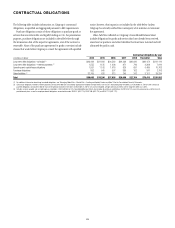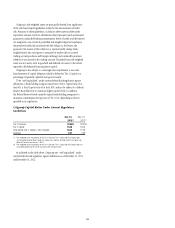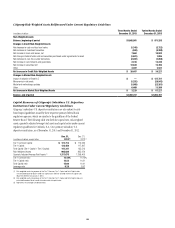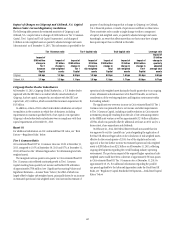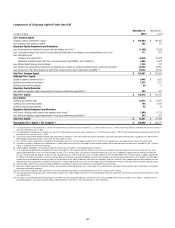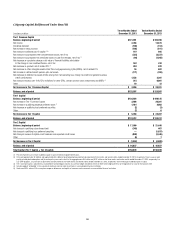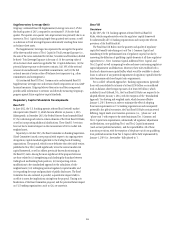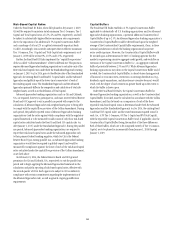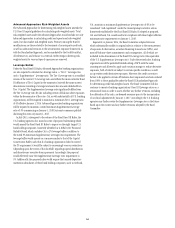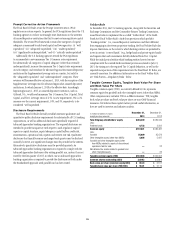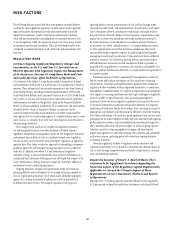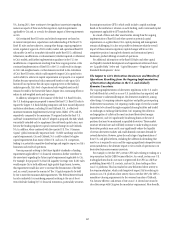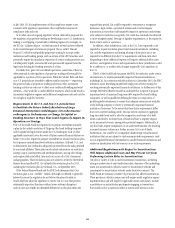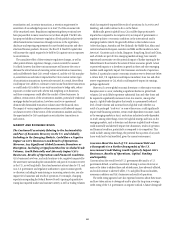Citibank 2013 Annual Report Download - page 69
Download and view the complete annual report
Please find page 69 of the 2013 Citibank annual report below. You can navigate through the pages in the report by either clicking on the pages listed below, or by using the keyword search tool below to find specific information within the annual report.51
Supplementary Leverage Ratio
Citigroup’s estimated Basel III Supplementary Leverage ratio was 5.4% for
the fourth quarter of 2013, compared to an estimated 5.1% for the third
quarter. The quarter-over-quarter ratio improvement was primarily due to an
increase in Tier 1 Capital arising largely from quarterly net income, as well
as a decrease in Total Leverage Exposure substantially resulting from lower
on-balance-sheet assets.
The Supplementary Leverage ratio represents the average for the quarter
of the three monthly ratios of Tier 1 Capital to Total Leverage Exposure (i.e.,
the sum of the ratios calculated for October, November and December, divided
by three). Total Leverage Exposure is the sum of: (i) the carrying value of
all on-balance-sheet assets less applicable Tier 1 Capital deductions; (ii) the
potential future exposure on derivative contracts; (iii) 10% of the notional
amount of unconditionally cancellable commitments; and (iv) the full
notional amount of certain other off-balance sheet exposures (e.g., other
commitments and contingencies).
Citi’s estimated Basel III Tier 1 Common ratio and estimated Basel III
Supplementary Leverage ratio and certain related components are non-GAAP
financial measures. Citigroup believes these ratios and their components
provide useful information to investors and others by measuring Citigroup’s
progress against future regulatory capital standards.
Regulatory Capital Standards Developments
Basel II.5
In June 2012, the U.S. banking agencies released final (revised) market
risk capital rules (Basel II.5), which became effective on January 1, 2013.
Subsequently, in December 2013, the Federal Reserve Board amended Basel
II.5 by conforming such rules to certain elements of the Final Basel III Rules,
as well as incorporating additional clarifications. These Basel II.5 revisions
have not had a material impact on the measurement of Citi’s market risk-
weighted assets.
Separately, in October 2013, the Basel Committee on Banking Supervision
(Basel Committee) issued a new proposal with respect to its ongoing review
of regulatory capital standards applicable to the trading book of banking
organizations. The proposal, which is more definitive than the initial version
published in May 2012, would significantly revise the current market risk
capital framework, as well as address previously known shortcomings in
the Basel II.5 rules. Among the more significant of the proposed revisions
are those related to (i) strengthening and clarifying the boundary between
trading book and banking book positions; (ii) incorporating certain
modifications to the standardized approach to the calculation of risk-
weighted assets; (iii) redesigning internal regulatory capital models; and
(iv) expanding the scope and granularity of public disclosures. The Basel
Committee has also initiated, in parallel, a quantitative impact study in
an effort to assess the implications arising from the proposal. Timing as to
finalization of the Basel Committee proposal, and the potential future impact
on U.S. banking organizations, such as Citi, are uncertain.
Basel III
Overview
In July 2013, the U.S. banking agencies released the Final Basel III
Rules, which comprehensively revise the regulatory capital framework
for substantially all U.S. banking organizations and incorporate relevant
provisions of the Dodd-Frank Act.
The Final Basel III Rules raise the quantity and quality of regulatory
capital by formally introducing not only Tier 1 Common Capital and
mandating it be the predominant form of regulatory capital, but also by
narrowing the definition of qualifying capital elements at all three regulatory
capital tiers (i.e., Tier 1 Common Capital, Additional Tier 1 Capital, and
Tier 2 Capital) as well as imposing broader and more constraining regulatory
capital adjustments and deductions. Moreover, these rules establish both a
fixed and a discretionary capital buffer, which would be available to absorb
losses in advance of any potential impairment of regulatory capital below the
stated minimum risk-based capital ratio requirements.
For so-called “Advanced Approaches” banking organizations (generally
those with consolidated total assets of at least $250 billion or consolidated
total on-balance-sheet foreign exposures of at least $10 billion), which
includes Citi and Citibank, N.A., the Final Basel III Rules are required to be
adopted effective January 1, 2014, with the exception of the “Standardized
Approach” for deriving risk-weighted assets, which becomes effective
January 1, 2015. However, in order to minimize the effect of adopting
these new requirements on U.S. banking organizations and consequently
potentially also global economies, the Final Basel III Rules contain several
differing, largely multi-year transition provisions (i.e., “phase-ins” and
“phase-outs”) with respect to the stated minimum Tier 1 Common and
Tier 1 Capital ratio requirements, substantially all regulatory adjustments
and deductions, non-qualifying Tier 1 and Tier 2 Capital instruments
(such as trust preferred securities), and the capital buffers. All of these
transition provisions, with the exception of the phase-out of non-qualifying
trust preferred securities from Tier 2 Capital, will be fully implemented by
January 1, 2019 (i.e., hereinafter “fully phased-in”).


